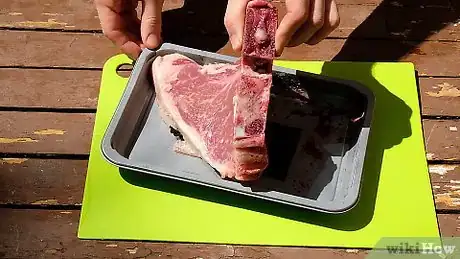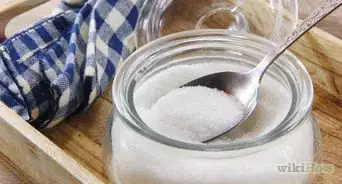This article was co-authored by Marrow Private Chefs. Marrow Private Chefs are based in Santa Rosa Beach, Florida. It is a chefs’ collaborative comprised of an ever-growing number of chefs and culinary professionals. Though regionally influenced primarily by coastal, traditional southern, cajun, and creole styles and flavors, the chefs at Marrow have a solid background in all types of cuisine with over 75 years of combined cooking experience.
There are 10 references cited in this article, which can be found at the bottom of the page.
This article has been viewed 48,718 times.
There is nothing like cutting into a high-quality steak seared to perfection on the grill. A T-bone is a great choice for grilling and doesn't require a lot of preparation. The key to a good T-bone steak is to season it in advance, then cook it indirectly before searing it. Cook the steak to the desired temperature and let it rest so it stays flavorful and juicy.
Ingredients
- 1 T-bone steak
- 1 teaspoon (5.69 g) of kosher salt
- 1 teaspoon (2.30 g) of black pepper
Makes 1 serving
- 4 T-bone steaks
- 2 teaspoons (4.2 g) of paprika
- ¾ teaspoon (1.35 g) of cayenne pepper
- ¾ teaspoon (1.80 g) of onion powder
- ¾ teaspoon (0.24 g) of garlic powder
- ¾ teaspoon (2.25 g) of turmeric
- ¾ teaspoon (1.35 g) of coriander.
Makes 4 servings
Making a Marinade
- T-bone steaks
- 1 cup (240 mL) of vegetable oil
- 3⁄4 cup (180 mL) of soy sauce
- 1⁄2 cup (120 mL) of lemon juice
- 1⁄4 cup (59 mL) of Worcestershire sauce
- ¼ cup (62.25 g) of yellow mustard
- 4 cloves of garlic, minced
Makes 8 servings
Steps
Choosing a Steak
-
1Pick a steak at least 1 in (2.5 cm) thick. A T-bone steak is actually 2 steaks combined. T-bone steaks are measured from the edge of the tenderloin, which is the smaller steak, to the bone. The other steak is a NY strip steak, which is larger and not as lean. Tenderloins cook faster than strip steaks, so get larger tenderloins to cook your steak evenly.[1]
- Although 1 1⁄2 in (3.8 cm) is the most common size for grilled T-bone steaks, choose a 1 in (2.5 cm)-thick steak if you desire less meat. Anything smaller than this is prone to overcooking on the grill.
- Larger steaks, such as those over 2 in (5.1 cm) in thickness, are also good on the grill but take longer to cook.
-
2Purchase steaks labeled as porterhouses for grilling. Porterhouse steaks are all technically T-bones. A T-bone is labeled as a porterhouse when the tenderloin is at least 1 1⁄2 in (3.8 cm) thick. If you see T-bone steaks labeled as porterhouses, you know right away they're the perfect size for grilling.[2]Advertisement
-
3Choose a T-bone with an even distribution of fat in the meat. Marbling is from the white streaks of fat within the steaks. The more even the marbling appears to be, the better your steak will cook on the grill. The fat also gives the steak plenty of flavor.[3]
- In the U.S., for instance, steaks are rated for quality. Prime steaks are the best cuts with the most marbling. Choice steaks are what most people grill. Select steaks are the lowest quality, so avoid them for grilling purposes.
- Also, pay attention to the fat around the outer edges of the steak. An 1⁄4 in (0.64 cm) layer of fat is ideal. If you see large chunks of white fat on the outer edge of the meat, you're going to pay for a part you can't eat.
Cleaning and Seasoning a Plain Steak
-
1Trim the extra fat and pat the steak dry. Set the steak down on a cutting board and slice excess fat off its outer edges. Leave at least 1⁄4 in (0.64 cm) of fat on the steak for flavor. Then, blot any remaining moisture off of the meat with a few paper towels.[4]
- Excess fat melts in the heat and drips into the grill, sometimes causing a flare-up. To avoid this, plan on cooking the steak away from direct heat with a drip pan under it. Then, finish the steak quickly over direct heat.
- Any moisture on the steak turns to steam, which cooks the meat and affects the sear.
-
2Season the steak with salt at least 40 minutes in advance. Cover both sides of the steak in a thick layer of about 1 teaspoon (5.69 g) of kosher salt. Adding the salt so far in advance draws the flavor out of the steak. The salt draws out the juices, which the steak reabsorbs before you cook it.[5]
- If you don't have time to wait, season the steak right before cooking it. That way, the steak's fibers won't have enough time to release juices. Unless you put the steak on the grill right away or wait the full 40 minutes, your steak will lose those juices as it cooks.
Mixing a Spice Rub
-
1Add other seasonings to the steak as desired. Let the steak's natural flavor shine through by including only salt and pepper. If you have a fresh, good-quality cut of meat, this is all you need to bring the best flavor out of it. Sprinkle about 1 teaspoon (2.30 g) of black pepper over the sides and edges of the steak. Add more pepper as desired to suit your tastes.[6]
- Another option is to wait and add the pepper after cooking the steak. The pepper tends to burn a little, leaving a bitter flavor. Some people don't like this, but others think it balances out the flavor.
- If you are willing to experiment, use other herbs and spices in a rub to give the T-bone additional flavor. For instance, mix together 2 teaspoons (4.2 g) of paprika, ¾ teaspoon (1.35 g) of cayenne pepper, ¾ teaspoon (1.80 g) of onion powder, ¾ teaspoon (0.24 g) of garlic powder, ¾ teaspoon (2.25 g) of turmeric, and ¾ teaspoon (1.35 g) of coriander.[7]
- Another option is to let the steak rest in a marinade for at least 2 hours. Make a basic marinade out of 3⁄4 cup (180 mL) of soy sauce, 1⁄2 cup (120 mL) of lemon juice, 1⁄4 cup (59 mL) of Worcestershire sauce, ¼ cup (62.25 g) of mustard, and 4 cloves of garlic to give the steak plenty of flavor.[8]
-
2Rest the steak at room temperature for at least 30 minutes. Leave the seasoned steak out on a plate as you begin heating up the grill. This gives the meat some time to dry out as the salt does its job. If you plan on seasoning the steak well in advance, store it in the refrigerator to prevent bacterial growth.
- A steak can be left out at room temperature for up to 2 hours before bacteria makes it inedible. Keep the steak in the refrigerator if you don't plan on cooking it within that time span.
Grilling and Searing the Steak
-
1Preheat 1 side of a grill to a medium setting, about 350 °F (177 °C). To test the grill, hold your hand about 5 in (13 cm) above the grate. If you are able to leave your hand there for only 3 to 4 seconds before getting too hot, the grill is at the right temperature.[9]
- For a charcoal grill, move the charcoal to 1 side. For a gas grill, activate the burners on 1 side. Leave the other side of the grill unheated to cook the steak indirectly.
- Other temperatures do work and are fine for cooking a T-bone quickly, but keep a close eye on the meat to prevent it from overcooking.
-
2Place the steak on the grill with the sirloin facing the heat. Keep the steak off of the heat for now with the tenderloin portion near the grill's outer edge. Put a grill pan underneath it to catch dripping fat. This method of cooking is called the reverse sear. It cooks the inside of the steak first.[10]
- The most common way to cook a steak is to sear the outside portion over direct heat first. The downside is that, with a thick cut like a T-bone, the steak's interior cooks inconsistently.
-
3Grill the steak for about 20 minutes until the interior is almost done. Keep a thermometer on hand and begin checking the center of the steak after about 10 minutes. The meat needs to be 5 °F (−15 °C) below the finished temperature you desire. At a minimum, cook the strip portion to 115 °F (46 °C) and the tenderloin to 110 °F (43 °C).[11]
- If you like your steak medium-rare, grill the strip portion to 125 °F (52 °C). For a medium steak, continue cooking to 135 °F (57 °C). Aim for 155 °F (68 °C) to make the steak well-done.[12]
- Remember that the cooking time depends on many different factors, including the size of the steak and your grill's settings. Your time may vary.
-
4Turn up the heat setting on your grill to high. Leave the steak on the grill. Add more coals to the heated side of the grill or adjust the gas burners to 450 °F (232 °C). Make sure the heated portion is blazing hot before you finish the steak over it. The steak is already cooked, so all you need to do to finish it is sear it quickly over direct heat.[13]
- When the grill is very hot, you will be able to hold your hand over it for 1 second or less.
-
5Sear the steak over direct heat for about 2 minutes per side. Cook the steak until it has a beautiful brown crust on the outside. Watch the steak the entire time to ensure it doesn't overcook. Flip it over using tongs or a strong spatula to finish searing the other side.[14]
- To get perfectly square grill marks, rotate the steak 90 degrees after about 90 seconds of cooking on each side. This isn't important, but some people prefer the visual appeal of great grill marks.
-
6Tent the steak in foil and let it rest for 10 minutes. Move the steak off of the grill, then loosely drape a piece of foil over it. The steak will finish cooking up to its finished temperature as it rests. Leaving the meat alone for a few minutes also causes it to absorb all of the juices, leading to a tastier steak.[15]
- At a minimum, wait 5 minutes before slicing the steak to avoid a slightly dry mess.
- Just before you serve or eat your steak, squeeze a few drops of fresh lemon juice over it. This will multiply the flavor even more.
- Store leftover steak in an airtight container or wrap. It lasts about 4 days in the refrigerator and 3 months in the freezer.[16]
Community Q&A
-
QuestionCant I grill the t-bone steak in an oven without having to cook it first?
 Community AnswerThe instructions for this recipe are new to me, I never thought of "cooking" first, then "searing"! I would think you could cook the steak in a very hot oven until it's about 5 F less than your preference. Have a skillet on medium high heat till it's very hot ready, then sear the steak for a minute or two on each side to get great color and seal in the juices. Be sure to let the steak rest off the heat for 5-10 minutes - it really does make a huge difference!
Community AnswerThe instructions for this recipe are new to me, I never thought of "cooking" first, then "searing"! I would think you could cook the steak in a very hot oven until it's about 5 F less than your preference. Have a skillet on medium high heat till it's very hot ready, then sear the steak for a minute or two on each side to get great color and seal in the juices. Be sure to let the steak rest off the heat for 5-10 minutes - it really does make a huge difference!
Things You'll Need
- Grill
- Olive oil
- Coal or gas
- Meat thermometer
- Tongs or spatula
- Plate or another resting surface
- Aluminum foil
- Carving knife
References
- ↑ https://www.seriouseats.com/2014/05/how-to-grill-t-bone-steak.html
- ↑ https://www.seriouseats.com/2014/05/how-to-grill-t-bone-steak.html
- ↑ https://www.seriouseats.com/2014/05/how-to-grill-t-bone-steak.html
- ↑ https://www.101cookingfortwo.com/how-to-grill-t-bone-or-porterhouse/
- ↑ https://www.epicurious.com/recipes/food/views/grilled-t-bone-steaks-232163
- ↑ https://www.epicurious.com/recipes/food/views/grilled-t-bone-steaks-232163
- ↑ https://www.allrecipes.com/recipe/213461/rocks-t-bone-steaks/
- ↑ https://www.allrecipes.com/recipe/214875/walls-t-bone-steak-marinade/
- ↑ https://www.epicurious.com/recipes/food/views/grilled-t-bone-steaks-232163
- ↑ https://www.allrecipes.com/recipe/246229/grilling-thick-steaks-the-reverse-sear/
- ↑ https://www.allrecipes.com/recipe/246229/grilling-thick-steaks-the-reverse-sear/
- ↑ https://whatscookingamerica.net/Information/MeatTemperatureChart.htm
- ↑ https://www.allrecipes.com/recipe/246229/grilling-thick-steaks-the-reverse-sear/
- ↑ https://www.seriouseats.com/2014/05/how-to-grill-t-bone-steak.html
- ↑ https://www.youtube.com/watch?v=URZc6_Jiukg&feature=youtu.be&t=75
- ↑ https://www.stilltasty.com/fooditems/index/16504
























































